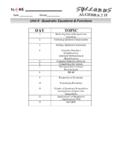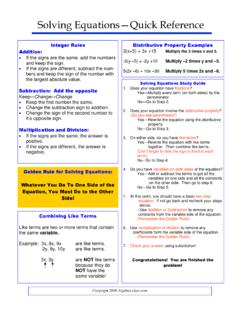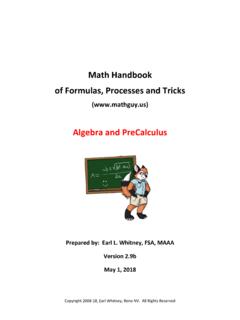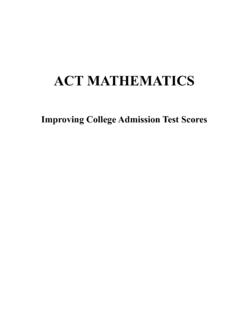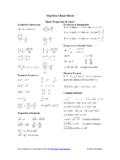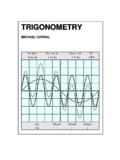Transcription of A2 Reference Sheet - MRS. STILLMAN
1 A2 Reference Sheet Number Sets quadratic Functions 3 Forms Form Equation Standard Form y=ax2+bx+c The x-coordinate of the vertex is x= b2a The axis of symmetry is x= b2a vertex Form y=ax h()2+k the vertex is h,k() Intercept Form y=ax p()x q() The x-intercepts are x=p and x=q. The x-coordinate of the vertex is the average of the x-intercepts. Graphing Quadratics plot the vertex and two other points, one to the left and one to the right of the vertex . Parent Function: y=x2 y=ax2+bx+c, a>0 MINIMUM value at the vertex y=ax2+bx+c, a<0 MAXIMUM value at the vertex Complex Numbers: a+bi (standard form) Imaginary Numbers: 1=i Powers of i i1=ii2= 1i3= ii4=1 Rationalizing with Complex Numbers Ex: 3+i7i *MULTIPLY the numerator and denominator by i 3+i7i ii3i+i27i23i 1 717 37i Ex: 3+i7 i *MULTIPLY the numerator and denominator by the conjugate of the denominator, 7+i 3+i7 i 7+i7+i21+10i+i249 i221+10i 149+120+10i5025+15i Completing the Square To complete the square: b2a!
2 "#$%&2 Use completing the square Rewrite a quadratic function from standard form to vertex form. y=2x2+12x+10y=2x2+6x____()____+10y=2x2+6 x+9() 18+10y=2x+3()2 8 Solve quadratic equations in standard form. x2 4x+5=0x2 4x____()____+5=0x2 4x+4() 4+5=0x 2()2+1=0x 2()2= 1x 2()2= 1x 2=ix 2= ix=2 i 4 Methods to Solve quadratic Equations Factoring Use when ax2+bx+c=0 and ac has a set of factors that sum to b Square Roots - Use when ax2+c=0 or ax h()2+k=0 Completing the Square Use whenax2+bx+c=0 (*Convenient when ba is even) quadratic Formula Use when ax2+bx+c=0 (*Convenient when a,b,c are small.) x= b b2 4ac2a The discriminant: b2 4ac *Use the discriminant to determine the number and type of roots(solutions) of a quadratic equation. If b2 4ac>0, Number of Solutions: 2 distinct Type of Solutions: real The graph of y=ax2+bx+c has two x-intercepts.
3 If b2 4ac=0, Number of Solutions: 1 repeated Type of Solutions: real The graph of y=ax2+bx+c has one x-intercept. If b2 4ac<0, Number of Solutions: 2 distinct Type of Solutions: imaginary The graph of y=ax2+bx+c has NO x-intercepts. Factoring Polynomial Functions Exponent Properties End Behavior Finding Zeros Using The Rational Zero Theorem Rational Exponents and Radical Functions Rational Exponents amn=am/n ex: Evaluate. 45/2=4()5=2()5=32 (easiest to take the root first!) ex: Simplify. a) 1353=27 53=353 (look for perfect powers) b) 2595=25325 335335=5453 Simplifying Roots Rule Example When n is odd xnn=x 64x3y53=4xyy23 When n is even xnn=x 32xy4x84=2x2y2x4 Function Operations Operation Definition Example: fx()=x2 3, gx()=x+2 Addition f+g()x()=fx()+gx() f+g()x()=x2 3+x+2=x2+x 1 Subtraction f g()x()=fx() gx() f g()x()=x2 3 x+2()=x2 x 5 Multiplication fg()x()=fx()gx() fg()x()=x2 3()x+2()=x3+2x2 3x 6 Division fg!
4 "#$%&x()=x2 3x+2 Compositions f!g()x()=fgx()() g!f()x()=gfx()() f!g()x()=fx+2()=x+2()2 3=x2+4x+1 g!f()x()=gx2 3()=x2 3+2=x2 1 fg!"#$%&x()=fx()gx()Inverse Functions Properties of Inverse Functions If fx() and gx()are inverse functions f!g()x()=xANDg!f()x()=x The graphs of fx() and gx()are reflections about the line y=x The domain of fx() is the range of gx(). The range of fx() is the domain of gx(). Iffx() contains the point (a, b) thengx() contains the point (b, a) To find an Inverse: Ex: fx()=x3+4 1. switch x and y x=y3+4 2. solve for y y=x 43 3. label appropriately f 1x()=x 43 Exponential and Logarithmic Functions Exponential Functions: y=abx (a 0,b>0, b 1) b is the growth/decay factor If 0<b<1, then y=abx represents exponential decay.
5 Ex: y=214!"#$%&x *notice the right side of the graph APPROACHES the asymptote If b>1, then y=abx represents exponential growth. Ex: y= 52"#$%&'x *notice the right side of the graph MOVES AWAY from the asymptote Solving Exponential Equations Cases Make the bases equal 9x 2=272x 532()x 2=33()2x 532x 4=36x 152x 4=6x 1612=4xx=3 Can t make the bases equal 2 5x+4 9= 35x+4=3log55x+4()=log53()x+4=log53x= 4+log53x= quadratic Form 32x+3x 12=03x()2+3x 12=0 Let u=3xu2+u 12=0u 3()u 4()=0u=3, u=43x=3, 3x 4x=1 Logarithm Properties Solving Logarithmic Equations *Goal ONE term on each side *CHECK FOR EXTRANEOUS SOLUTIONS 3lnx 4()+2= 4lnx 4()= 2elnx 4()=e 2x 4=e 2x=4+e 2x= log2x+logx 5()=log100()log2x2 10x()=log100()10log2x2 10x()=10log100()2x2 10x=1002x2 10x 100=0x2 5x 50=0x 10()x+5()
6 =0x=10, x= 5 x= 5 is extraneous, the answer is x=10 Compound Interest Interest Compounded n times per year A=P1+rn!"#$%&nt A is the final amount P is the initial amount r is the interest rate, in decimal form t is the time in years n is the number of times the interest is compounded per year Interest Compounded Continuously A=Pert A is the final amount P is the initial amount r is the interest rate, in decimal form t is the time in years Domain Restrictions Fractions: y=fx()gx() Domain:xgx() 0{} Ex: y=x2+9x 2, xx 2{} Ex: y=x 2x2+9, xx R{} Even Roots: y=fx()n, n is even Domain: xfx() 0{} Ex: y=2x+7 3, xx 7{} Logarithms: y=logbfx()() Domain: xfx()>0{} Ex: y= 2lnx+4, xx>0{}

